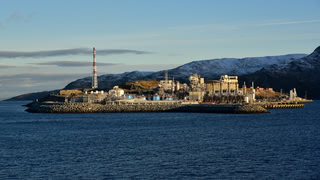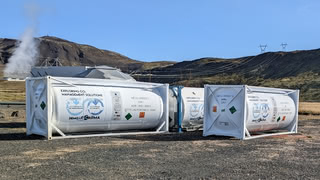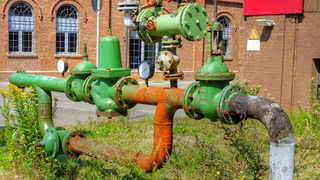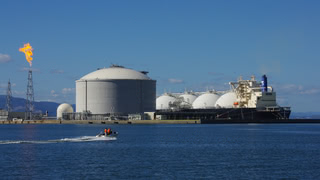Can CCS Escape from its Fossil Fuel Industry Roots?
Carbon capture and storage could help stop carbon dioxide emissions that are otherwise hard to avoid. But the technology is surrounded by controversies and is closely tied to the fossil fuel industry.
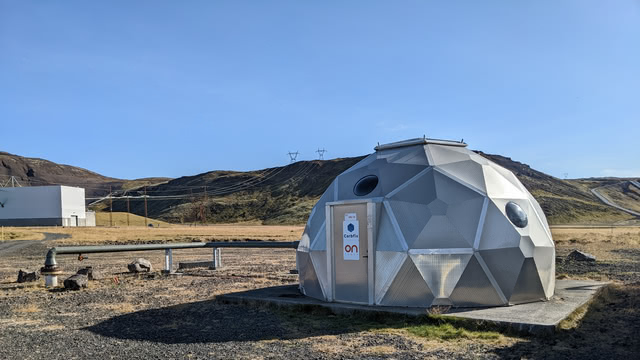
Can carbon dioxide emissions from power plants or industrial facilities be captured and stored underground? That is the idea of carbon capture and storage (CCS). But this technology is controversial, and to this day, only a few CCS facilities are operational worldwide.
The history of CCS starts with a technology called enhanced oil recovery. In the 1970s, oil companies in the United States began injecting carbon dioxide into old oil fields. It allowed extracting more oil from those aging fields.
Initially, the intent was neither to avoid carbon dioxide emissions nor to protect the climate. It was only later that this process was rebranded into a potential climate solution, as some carbon dioxide would stay underground.
Most CCS projects involve Enhanced Oil Recovery
Up until this day, the majority of CCS projects are enhanced oil recovery projects. The Global CCS Institute lists 30 active CCS projects in its latest report from 2022. Of those, 22 use enhanced oil recovery.
The history of CCS took a new turn with the Sleipner project in Norway. The Nordic country was among the first to implement a carbon tax in 1991. It gave companies a financial incentive to reduce their carbon dioxide emissions and led to the first dedicated CCS project, i.e., not using enhanced oil recovery.
Norway's state oil company Statoil, today known as Equinor, started injecting carbon dioxide into a saline aquifer below the Sleipner gas field in 1996. Since 2004, Statoil has operated a second, similar CCS project in the Snøhvit gas field. (A recent podcast by the Global CCS Institute with Olav Kårstad, who was involved in the Sleipner CCS project, is worth listening to if you want to learn more about its history.)
The carbon dioxide injected in the Sleipner and Snøhvit projects comes from gas processing facilities. Fossil gas drilled in these fields comes mixed with carbon dioxide, which needs to be separated before the gas can be further distributed.
Such gas processing facilities are a common carbon dioxide source for CCS and EOR projects. 13 of the 30 active CCS projects source carbon dioxide from gas processing.
Therefore, most existing CCS facilities involve fossil fuel production via enhanced oil recovery or by sourcing carbon dioxide from fossil fuel processing facilities. While these facilities lead to slightly lower emissions in the production steps, they do nothing to mitigate the emissions caused by the consumption of these fossil fuels.
Technologies that use carbon dioxide instead of merely storing it are sometimes called Carbon Capture and Utilization (CCU). Technically, enhanced oil recovery is a type of CCU. It also covers technologies that turn carbon dioxide and hydrogen into hydrocarbons like methanol that can be used as a fuel or a chemical feedstock.
CCU is often lumped together with CCS, and sometimes the umbrella term CCUS is used. But it is important to note that CCU technologies that produce fuels or chemicals are quite different from CCS. While they use the same capture technologies, they do not lead to permanent emission avoidance. They merely delay emissions and are a form of double use of carbon molecules.
The Failure of Clean Coal
In 2007, electricity and coal companies from the United States started a PR and TV ad campaign pushing the idea of clean coal. It implied that CCS technology would allow the continuing use of coal as an electricity source while avoiding its emissions.
Clean coal received considerable and bipartisan political support in the United States. Both the Democratic presidential candidate and later President Barack Obama and his Republican opponent John McCain made statements supporting clean coal during their election campaigns.
Discussions about clean coal also happened in other countries. Around that time, electricity companies in Germany had plans for 30 new coal-fired power plants. Eventually, ten of those were built, often with the argument that they were CCS-ready.
As mentioned, most existing CCS projects are at gas processing facilities. In those facilities, carbon dioxide is available in high concentrations, making capturing and liquefying it relatively easy.
It is a different story for post-combustion CCS in facilities that burns fossil fuels. The exhaust stream of a coal-fired power plant contains 70 percent nitrogen and only around 10-15 percent carbon dioxide. For a gas-fired power plant, the concentration is even lower. Separating carbon dioxide from those other gases requires an expensive and energy-intensive technology called amine washing.
An alternative is to burn fuels in oxygen instead of air to avoid the nitrogen content of the exhaust gas. It leads to an exhaust stream of water vapor and carbon dioxide, which is easier to separate. CCS with oxyfuel technology was tested in a few pilot plants, but today there are no large-scale operational projects. (The company NET Power operates a small pilot plant in Texas.)
These and other challenges made CCS for power plants so expensive that only a few projects went into operation. In the United States, only one clean coal project named Petra Nova went online for only a few years.
Like most CCS projects, Petra Nova uses enhanced oil recovery. Carbon capture was implemented in one of the four blocks of a coal-fired power plant in Thompsons, Texas. It only targeted a capture rate of around a third of that coal block.
Fossil gas provided the energy for the CCS facility. And before you ask: No, carbon dioxide produced by the gas burned in order to power the CCS facility was not captured.
Petra Nova was shut down in 2020 due to low oil prices – the economics of the carbon capture plant relied on the income generated by enhanced oil recovery. The coal power plant is still running – without CCS. (For more details about clean coal and the Petra Nova project, I recommend watching this video by the YouTube channel Climate Town.)
Only one coal CCS project is still operational, Boundary Dam in Canada. It originally had a planned capture rate of 90 percent. But the capture unit had significant downtimes, leading to much lower effective capture rates. In 2021, it achieved a capture rate of 44 percent. (Though it did achieve much higher capture rates in 2022.)
CCS is sometimes pictured as a technology that allows emission-free use of fossil fuels. But existing CCS projects usually do not achieve very high capture rates. That is not to say that future CCS projects could not do much better. But even new projects planned today often expect surprisingly low capture rates. For example, the Brevik project in Norway, the only CCS facility for a cement plant currently under construction, expects a capture rate of only 50 percent.
BECCS introduces the idea of Carbon Dioxide Removal
An idea that eventually played an important role in climate models is the combination of bioenergy and CCS, often abbreviated BECCS. Burning biomass, whether wood, biogas, or other sources, produces carbon dioxide. However, the carbon content of that biomass came from the air while the plants were growing.
This is often simplified as saying that bioenergy is climate neutral. But that comes with a lot of caveats and largely depends on the source of the biomass. Growing biomass for energy leads to substantial land use, and the related land-use changes also lead to emissions. In some cases, bioenergy can have higher emissions than fossil fuels.
Still, bioenergy combined with CCS could deliver negative emissions under the right circumstances. Carbon dioxide is stored permanently underground, and the carbon content comes from plants that initially took carbon dioxide out of the air. BECCS and other technologies that remove carbon dioxide from the atmosphere are also summarized as carbon dioxide removal or CDR.
This possibility of negative emissions found its way into climate scenarios. By assuming that in the future, humanity will be able to undo emissions, in many scenarios, it is assumed that humanity will "overshoot" certain atmospheric carbon dioxide levels and bring them back down later.
A different type of CCS in Iceland
A CCS project that is unique in many ways is Carbfix in Iceland. The country uses geothermal energy for most of its heating and a substantial part of its electricity production. Geothermal energy is a renewable and relatively clean source of energy. Still, geothermal energy comes with emissions of unwanted gases – carbon dioxide and hydrogen sulfide, which can be a health risk.
Carbfix is a subsidiary of Orkuveita Reykjavíkur, Rekjavik's local energy company, which also operates Iceland's largest geothermal power plant Hellisheiði. It has developed technologies to store hydrogen sulfide and carbon dioxide emissions. Carbfix is the only major player in the CCS space not directly connected to the fossil fuel industry. And its CCS technology works quite differently from the ones used elsewhere.
With the Carbfix technology, carbon dioxide is dissolved in water and eventually reacts with basalt stone. In other words: Carbon dioxide is turned into stone. It alleviates any concerns people may have about carbon dioxide returning after injection. While most scientists consider carbon dioxide leakage risks from CCS manageable, such leaks have happened in enhanced oil recovery projects. (I am unaware of any documented leaks in aquifer storage sites, which is the typical geological storage in other non-EOR CCS projects.)
Carbfix also collaborates with Climeworks from Switzerland, a company developing direct air capture technology. The world's largest direct air capture plant, Orca, is located near the Hellisheiði power plant. Climeworks' Orca plant filters carbon dioxide from the air, and Carbfix stores it.
Such direct air capture technology is another type of carbon dioxide removal. However, as explained earlier, the more diluted carbon dioxide is, the more energy intensive and expensive it is to capture that carbon dioxide. With direct air capture, this problem is exacerbated. Air only has a carbon dioxide concentration of around 0,04 percent.
Direct air capture does not require as much land as BECCS and therefore does not come with the same land-use concerns. But it requires enormous amounts of energy, and the amount of carbon dioxide captured today is tiny. The Orca plant can capture 4,000 tons of carbon dioxide per year. As a comparison, Sleipner in Norway, the world's largest non-EOR CCS project, captures 250 times as much.
"A deadly embrace with the oil and gas sector"
CCS is controversial, and climate advocates and environmental groups often end up on different sides of this debate. While some vocally support CCS deployment, others reject the technology entirely.
The strongest argument against CCS is that it has been used as a delay tactic by the fossil fuel industry. "CCS-ready" coal-fired power plants have been built under the pretense that they would eventually be emission-free, which never happened, and was never realistic. The majority of CCS projects today are directly connected to fossil fuel production.
But there are important arguments favoring CCS that cannot be easily dismissed. Some industrial processes involve unavoidable carbon dioxide emissions without any plausible alternatives available anytime soon. The most notable is the production of cement, which I covered in a previous newsletter.
The other argument that is hard to dismiss is that there may be a need for carbon dioxide removal technologies in the future. BECCS and DAC each come with different but substantial challenges, but most people agree these technologies should at least be researched and developed. Whether they should be deployed at scale yet is, however, more controversial.
I talked to Marco Mazzotti from ETH Zürich, one of the leading scientists in the field of CCS. Mazzotti is supportive of faster deployment of CCS technology. But he is also concerned about the fossil fuel industry's influence on the sector. "We thought we escaped the deadly embrace with the coal industry and moved towards hard-to-abate sectors like cement. But the CCS sector is still caught in a deadly embrace with the oil and gas sector."
At the recent Trondheim CCS conference, an important event for the CCS research community, Mazzotti gave a keynote speech where he elaborated on his criticism of the oil and gas industry's influence on the field. From what Mazzotti told me, this is usually not happening at major CCS events.
Mazzotti expects that even with optimistic projections, the combined contribution of CCS and CDR technologies will remain a small part of the climate solution. The majority of emission reductions need to come from decreasing fossil fuel production. Yet the oil and gas companies developing CCS technologies seem to have no serious plans to do so.
Shipping Carbon Dioxide to Iceland and Norway
In recent years, CCS has seen a newly increased interest. Both Norway and Iceland plan to implement CCS projects that take emissions from industrial sites all over Europe via ship. A Swiss research project already shipped carbon dioxide to Iceland in containers – I wrote more about that project here.
If you have read this far, I hope you take one thing away: CCS projects differ substantially, and these differences often get lost in heated debates. An important question is how CCS projects relate to fossil fuel production and whether they are compatible with a climate-neutral future. The better debate would probably not be whether CCS is needed but what kind of CCS would be most beneficial for the climate.
Update (8th Nov 2023): Added note about oxyfuel pilot project by NET Power.
Author: Hanno Böck
Brief
-
SteelWatch is a new advocacy organization for a decarbonized steel sector. It published a report titled "Sunsetting Coal in Steel Production".
-
Recommended reading: Fraser Maywood discusses whether fossil fuel companies can be part of the energy transition. (Spoiler: Probably not.)
-
Agora Energiewende has published a report about the transformation of the chemical industry toward climate neutrality. (German only, one of the co-authors wrote a very brief summary on LinkedIn.)
-
Researchers from the Potsdam Institute for Climate Impact Research (PIK) looked at plausible scale-up options for green hydrogen production in a paper published in Nature Energy. Even with exceptional growth rates, green hydrogen will only provide a relatively minor share of global energy by 2040. Jan Rosenow summarized the paper in a post on LinkedIn.
